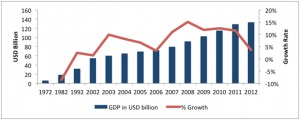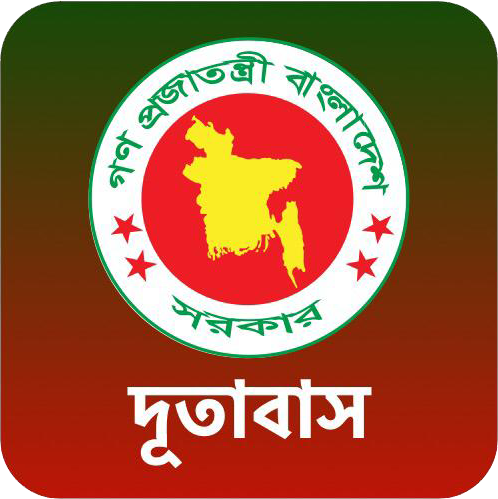Bangladesh Economy at a Glance
| Rank | 51 (nominal) /35 (ppp) |
| Currency | Bangladesh Taka (BDT) |
| Fiscal Year | 1 July – 30 June |
| Trade organizations | WTO, WCO, IOR-ARC, SAFTA, D8 |
Statistics
| GDP | $153.6 billion ((nominal) 43rd; 2012 est.)$347 billion ((PPP) 33rd; 2012 est.) |
| GDP growth | 6.7% (2013 est.) |
| GDP per capita | $1,044 (nominal: 150th; 2013) $2,210 (PPP” 145th; 2013 est.) |
| GDP by sector | agriculture: 17.3%, industry: 28.6%, services: 54.1% (2012 est.) |
| Inflation(CPI) | 8.8% (2012) |
| Population below poverty line |
24 % (2013 est.) |
| Gini coefficient | 32.1 (2007) |
| Labour force | 87.9 million (2013) |
| Labour force by occupation |
agriculture: 45%, industry: 30%, services: 25% (2008) |
| Unemployment | 5% (2012 est.) |
| Main industries | textiles and apparel, jute, tea, leather, telecommunications, pharmaceuticals, cement, ceramics, shipbuilding, fertilizer, food processing, paper newsprint, light engineering, sugar, fisheries, rubber, ship repairing, agriculture |
| Ease of doing business rank | 117th |
Bangladesh – The Next Asian Tiger
- Bangladesh has made remarkable progress in raising incomes, reducing poverty and improving social indicators and has been upgraded as a “Lower Middle-Income Country” by World Bank under the dynamic leadership of the current Prime Minister Sheikh Hasina.
- Bangladesh has experienced average GDP growth rate of 6 percent over the past decade. The seventh five year plan has forecast the average economic growth rate of Bangladesh over the next five years will be 7.4 percent.
- The country has been classified as a “Next Eleven” emerging market and one of the “Frontier Five” emerging economies in the world by Goldman Sachs and JP Morgan respectively.
- Middle-class people is rising rapidly and would be 25 percent of the total population by 2025. The huge demographic dividend has created the window of economic opportunity for Bangladesh. Poverty has been reducing about 2 percent per year and the predication says that it will come down to 8 percent by 2021.
- The country of 160 million people is characterized by a vibrant domestic consumer market Bangladesh is a largely homogeneous society with no major internal or external threats and a population with great resilience in the face of adversity. A huge labor with enthusiasm, hardworking ability and specifically with cheaper cost is suitable for any labor-intensive industry.
- Remittances from the Bangladeshi diaspora which is around 8.6 million provide vital foreign exchange. The reserve exceeded US$27 billion in October, 2015.
- The Bangladesh textile industry is the second-largest in the world and has been forecasted to exports to the value of US$50 billion by 2021. Other key sectors including leather and leather products, Jute and Jute goods, Agricultural products, pharmaceuticals and Engineering products have been growing rapidly.
- Being a bridge between South and South-East Asia, Bangladesh has a great advantage of her strategic location under the shadow of two giants China and India. Bangladesh has achieved annual export growth rate of 13.6 % over the last ten years – a testimony to its export competitiveness. Our export is diversifying from labor-intensive to capital-intesive industry which has been coined as a move from “Shirt to Ship”
Macroeconomic Outlook:
The economy has observed sustainable economic growth, exports have increased and foreign reserves have flourished over the decade in spite of the global economic crisis in 2008-09 and a series of natural disasters, to which Bangladesh is regularly susceptible. The Gross Domestic Product (GDP) of Bangladesh was worth US$ 174 billion in 2014. Bangladesh has experienced average GDP growth rate of 6 percent over the decade. The average growth rate is projected at 7.4 percent over the Seventh Five Year Plan (2016-2020) period. Bangladesh exports increased to about US$ 35 billion in 2014, which is about 20 percent of GDP whereas, in 2009, the number was merely US$ 17 billion. Trade GDP ratio has progressed immensely and is now approximately 45 percent in 2014. The export friendly ecosystem in the country has played a vital role to make this shift happen.
Fig 1: GDP Growth rate of Bangladesh

Source: World Development Indicators (2015), World Bank
Fig 2: Trade Growth of Bangladesh
Source: World Development Indicators (2015), World Bank
There has been a remarkable advance in the growth of foreign remittances. In 2014, it exceeded US$ 15 billion, whereas, in 2009 the number was less than US$ 10 billion. In October 2015, Bangladesh foreign exchange reserves reached US$ 27 billion, which is the highest in the history of the country, and which is sufficient for about 6 months of import payment. The trend of foreign investment inflows suggests that investment in Bangladesh is on the rise in recent years.
Fig 3: Foreign Reserve and Remittance Growth in Bangladesh
Source: Bangladesh Bank (2015)
Box 1: Perspective Plan of Bangladesh (2010 – 2021): Making Vision 2021 a Reality
| The year 2021 marks the 50th anniversary of independence of Bangladesh. In recognition of
the long-term development challenges, the Government under the leadership of Prime Minister Sheikh Hasina adopted the Vision 2021. The Vision 2021 and the associated Perspective Plan 2010-2021 have set solid development targets for Bangladesh by the end of 2021. Those targets, if achieved, will transform the socio-economic environment of Bangladesh from a low income economy to a middle income economy. The Bangladesh economy will be managed within the framework of a market economy with appropriate government interventions to correct market distortions, to ensure equality of opportunity, and to ensure equity and social justice for all. Those development priorities include ensuring broad-based growth and reducing poverty, ensuring effective governance and sound institutions by creating a caring society; addressing globalization and regional cooperation; providing energy security for development and welfare; building a sound infrastructure and managing the urban challenge; mitigating the impacts of climate change; and promoting innovation in a knowledge-based society. These thematic approaches will shape and form the foundation on which specific strategies are developed over the period of two five-year plans (Sixth and Seventh Five Year Plans). |
Source: Perspective Plan of Bangladesh (2010 – 2021), Planning Commission
Fig 4: Foreign Direct Investment in Bangladesh
Source: UNCTAD Investment Report (2015)
The World Investment Report 2015 also identifies that the country attracted Foreign Direct Investment (FDI) of US$1.53 billion in 2014. During the tenure of the current Prime Minister Sheikh Hasina, the Government has taken a number of large-scale development initiatives. Major projects include: Padma Bridge, Metro Rail, Nuclear Power Plant and Rampal Coal Power Project.
Box 2: Seventh Five Year Plan (2016-2020): Accelerating Growth, Empowering Citizens
| The Government’s Vision 2021 defines several economic and social outcomes for Bangladesh to achieve by 2021. To convert this Vision into long-term development targets, a Perspective Plan 2010-2021 was prepared. The targets of Vision 2021 and the associated Perspective Plan 2010-2021 were to be achieved through the implementation of two five-year plans, the Sixth Five Year Plan (2011-15) and the Seventh Five Year Plan (2016-2020).
The 7th Plan seeks to raise the GDP growth rate progressively from 6.5% in FY15 to 8% by FY20. The average growth rate is projected at 7.4% over the Seventh Plan period. It therefore encapsulates a strategy for inclusive growth which empowers people by creating employment opportunities, fostering the scope for greater labor force participation, particularly of women, supporting skill development in response to market demand, enabling access to credit for small and medium enterprises, and many other ways for people to be more productive. With about a quarter of the population of 160 million still living below the poverty line, faster growth is a necessary condition for attacking poverty. The 7th Plan seeks to reduce poverty rate to 18.6% and extreme poverty to around 8.9% by FY2020. Along with growth, the 7th Plan will emphasize human development, social protection and social inclusion as essential elements of a comprehensive poverty reduction strategy. It is estimated that some 12.9 million additional jobs will be available during the five years of the 7th FYP, including some 2 million jobs abroad for migrant workers, during the same period. |
Source: Seventh Five Year Plan (FY2016-2020): Planning Commission






